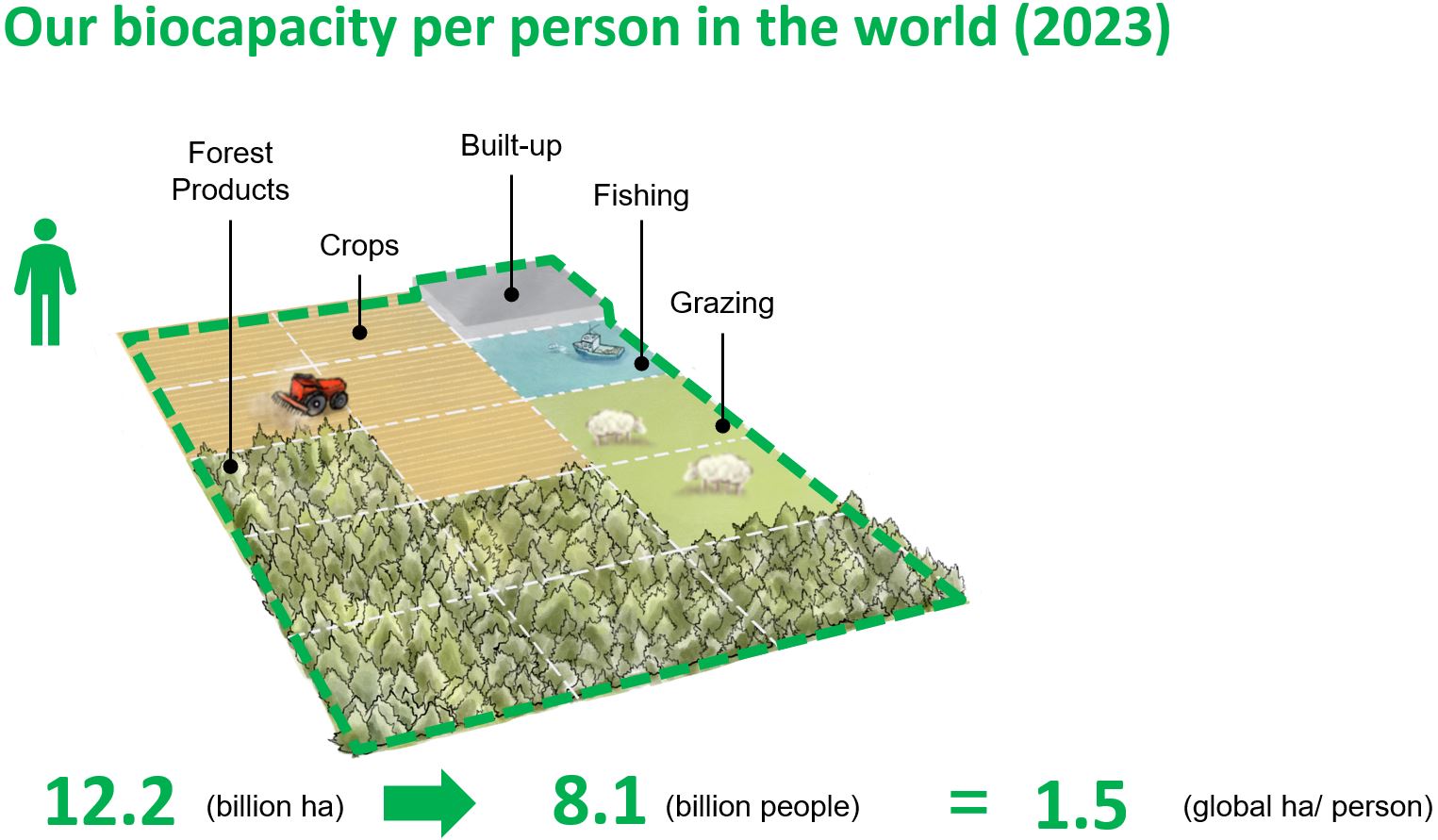What Biocapacity measures
Biocapacity stands for the regenerative capacity of our planet’s ecosystems. The biocapacity metric, therefore, quantifies the renewal rate of ecosystems around the globe. It tracks ecosystem’s inherent ability to renew biomass. This amount then can be compared to the amount of human demand on biocapacity, which is called people’s ecological footprint.
Biocapacity accounting allows researchers to determine how big human economies are compared to the size of the region’s, the country’s, or the planet’s ecosystems. More specifically, biocapacity accounting tracks the size of human economies compared to the renewal capacity of the entire planet or any of its regions.

Given the 12.2 billion hectares of biologically productive area on our planet and 8.1 billion people in 2023, this means that there were 1.5 global hectares of biocapacity per person on Earth. (We gratefully acknowledge Foster+Partners for producing the initial version of this illustration).
Such comparisons are relevant for those studying the biological resource dependence of economies. Note that some portion of the planet’s biocapacity is also needed to maintain biodiversity (Wilson 2016). If indeed the biological resources are materially the most limiting factor for the human economy, then mapping the ratio of the ecological footprint to the ecosystem’s biocapacity over time becomes foundational for any economic consideration.
To make biocapacity operational, it is measured in biologically productive surface area of the planet. To make different surfaces comparable, they are scaled by their relative biological productivity, ideally in terms of the potential net primary productivity of that area. We say “ideally” because data often does not exist to directly measure “potential net NPP” (net primary productivity). So often proxy assessments are used, until one day, better data will be available.
The measurement unit for the biocapacity metric is, as for the Ecological Footprint, “global hectares.” A global hectare is a biologically productive hectare with world-average productivity.
In most applications, as with any metric, biocapacity estimates are approximated. For instance, National Footprint and Biocapacity Accounts use yield factors and equivalence factors to estimate relative biocapacity of areas. Yield factors describe relative yields among the same area type, while equivalence factors compare productivity across area types. This then allows analysts to scale each hectare to global hectares. This national accounting approach is described in detail in Lin et al. (2018), Borucke et al. (2013), and in the supplement of Wackernagel et al. (2021).
The same logic can then also be applied to sub-national scales. The Ecological Footprint standards (https://www.footprintstandards.org), published in 2009, explain how.
National results on biocapacity trends of countries are available on the Footprint data platform.
For more details visit the introduction to the Ecological Footprint, or review the Frequently Asked Questions.
References
- Borucke, M. Moore, D. Cranston, G. Gracey, K. Iha, K. Larson, J. Lazarus, E. Morales, J. Wackernagel, M. and Gall A. 2013. Accounting for demand and supply of the Biosphere’s regenerative capacity: The National Footprint Accounts’ underlying methodology and framework. Ecological Indicators, 24, pp. 518–33. https://doi.org/10.1016/j.ecolind.2012.08.005
- Lin, David; Hanscom, Laurel; Murthy, Adeline; Galli, Alessandro; Evans, Mikel; Neill, Evan; Mancini, Maria S.; Martindill, Jon; Medouar, Fatime-Zahra; Huang, Shiyu; Wackernagel, Mathis. 2018. “Ecological Footprint Accounting for Countries: Updates and Results of the National Footprint Accounts, 2012–2018.” Resources 7, no. 3: 58. https://www.mdpi.com/2079-9276/7/3/58
- Wackernagel, Mathis; Laurel Hanscom, Priyangi Jayasinghe, David Lin, Adeline Murthy, Evan Neill, Peter Raven. 2021. “The Importance of Resource Security for Poverty Eradication.” Nature Sustainability. https://dx.doi.org/10.1038/s41893-021-00708-4
- Wilson, E.O. 2016, Half-Earth: Our Planet’s Fight for Life. New York, Liveright, USA.


